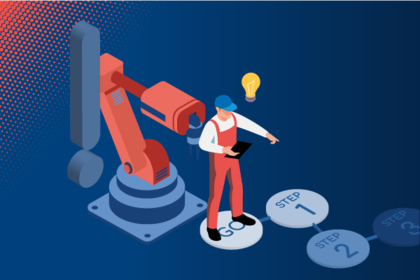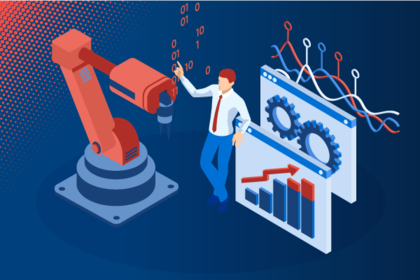5 Challenges That Service Managers Must Solve Now
Machine and plant manufacturers must develop new business models and cut costs to remain competitive. Service managers and their teams play an important role in this. This article shows which 5 major challenges they are currently facing, and which approaches to solving them are effective.

The role of the service manager in modern organizations
To be successful in their demanding job, service and maintenance managers need to be structured and service-oriented. In the future, these qualities will become even more important. In fact, service is undergoing a profound transformation that will present service managers and their teams with major challenges.
What does the future of service look like?
Technological and social developments have a major influence on the goals and challenges of aftersales and service. The KVD TrendRadar 2022 shows, among other things, which topics are currently occupying service teams in mechanical engineering. From the theses set out in the report, the following developments can be derived:
- Sustainability is becoming increasingly important in terms of image improvement and cost savings.
- The provision of subscription business models as part of the service offering is now inevitable.
- The service of the future is data-based and thrives on connections - between companies and customers as well as between service technicians and machines.
- The expansion of self-service models will increase and give service technicians more time for their core tasks.
- A positive customer experience will become one of the most important success factors by which service must be measured.
5 challenges for service managers
One thing is clear: The agenda for service managers includes efficiency, networked processes, satisfied customers and employees, and the expansion of the service offering. However, there are some major hurdles to overcome first on the way there.
The following overview shows the five most important challenges and how service managers can help solve them.
1. Skills shortage
More and more machine and plant manufacturers are feeling the effects of demographic change. The aftersales department also has to compensate for a lack of manpower. Among other things, the skills shortage in this area means that
- fewer and fewer employees must perform more and more tasks
- the willingness of service technicians to travel is declining
- knowledge is lost with departing employees
Dwindling know-how and overwork mean that customers' problems can no longer be solved quickly enough. Remote services, networked knowledge management and intuitive software solutions can prevent this. In many companies, however, such approaches are still dreams of the future.
Digital spare parts catalogs offer an effective approach. They combine spare parts and service information, are always up-to-date and can be used intuitively. This means that new employees can also use them quickly. In addition, spare parts catalogs bundle the knowledge of the service team and make it available to your service technicians in the office or at the customer site.
As a service manager, you hold a key position in your organization. You are the interface between aftersales and general management, and in this role, you have the opportunity to drive optimization - for example, with digital spare parts catalogs.
2. Lack of resources
Manufacturers of machinery and equipment lack not only skilled workers, but often spare parts and time as well. The problem is exacerbated when service teams have to work with outdated processes and data silos.
As a service manager, you usually have the best overview of the processes and information in your team. You know the most important touch points with other departments and key stakeholders in the company as well as with customers.
Your task now is to find suitable tools based on this information. If you succeed, you and your team will benefit from, among other things
- smooth spare parts logistics
- optimally planned service calls
- seamless information exchange with other departments
- more efficient aftersales processes
- more time for developing new service offerings
3. Digitization
Outdated operating manuals in paper form, incomplete documentation and neglected databases are still part of everyday life for many service teams. This situation must be overcome as soon as possible.
As systems and machines become increasingly complex, service technicians are dependent on clear and up-to-date data. Consequently, there is no way around the digitization of service processes.
This leads to the following advantages:
- The networking of service information, machine, and spare parts data, for example in a digital spare parts catalog, saves a lot of time in everyday service.
- Service calls can be shortened or carried out remotely.
- Maintenance can be planned better - which also saves time and money for operators.
- Service technicians identify spare parts faster and order the right parts.
Digital spare parts catalogs form the technological basis for all these optimizations and further digitization in service.
4. Cost pressure
Rising costs are forcing companies to save money. One important lever in aftersales is reducing errors, which still occur frequently, especially when ordering spare parts. Due to the increasing complexity of machines and systems, it is becoming more and more difficult for service technicians to identify the right spare part for their service call.
A spare parts catalog reduces incorrect orders. If the catalog is linked to the ERP system, customers can even find and order spare parts themselves. This leads to an additional boost in sales.
5. Service Excellence
Servitization is one of the megatrends in mechanical and plant engineering. The digitization of aftersales is the basis for new business models and a prerequisite for service excellence. Manufacturers who take this step can increase their first time fix rate and customer satisfaction.
As a service manager, you should actively drive the issue forward. It is true that your service technicians organize their day-to-day work independently. But with digital support, they can do their job even more efficiently and keep your customers completely satisfied.
There are many arguments that will also convince top management of the benefits of "Service 4.0":
- With digital services, customers can be satisfied faster and around the clock.
- Service calls are shortened, and travel costs are saved.
- Customer inquiries can be handled better - also via modern and digital channels such as chatbots.
How does software help service managers with their challenges?
Aftersales and service managers have the task of leading their organization's service business into the future. They are also responsible for increasing plant and machine availability and developing new sources of revenue.
Digital spare parts catalogs help with this. Service technicians are given a practical tool for their day-to-day work. And service managers create a basis for new services and more efficient processes.
Read more about the specific benefits of a spare parts catalog for your service team in the second part of this blog series.






